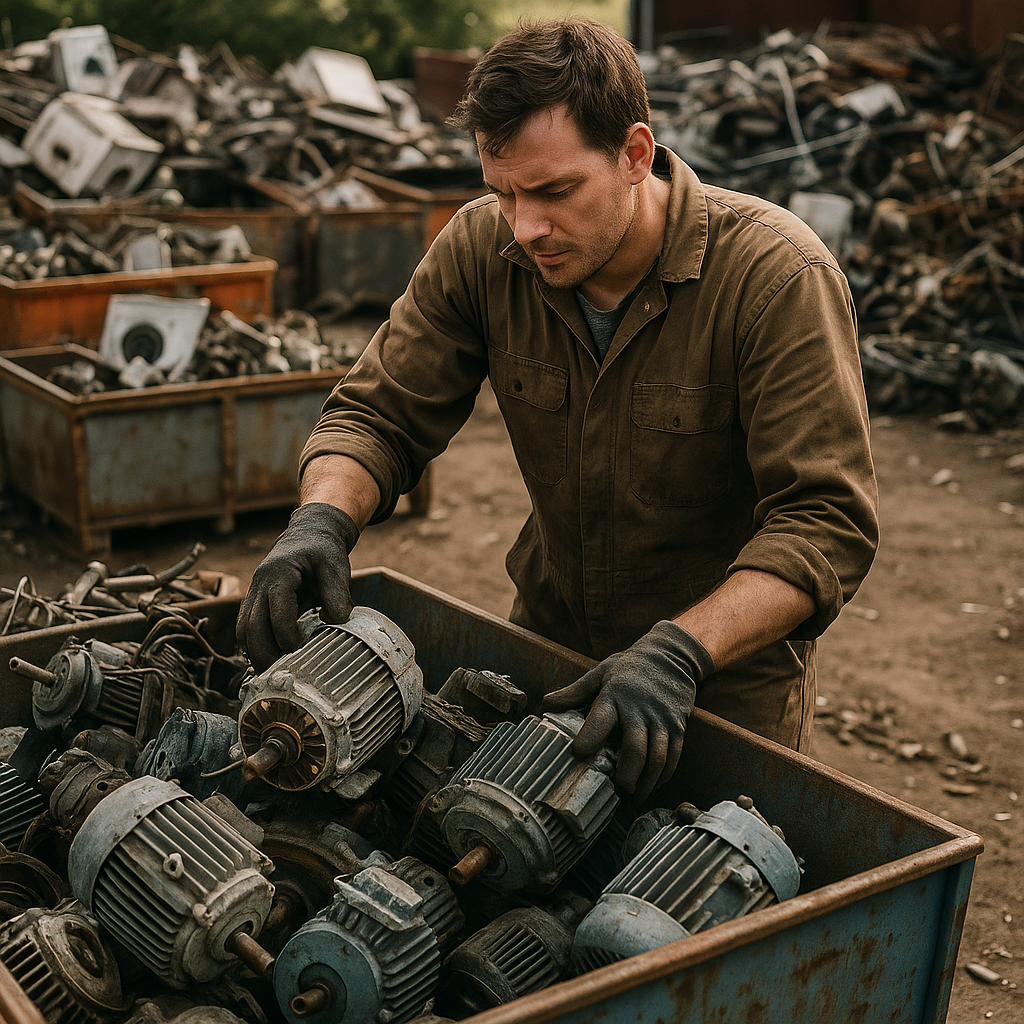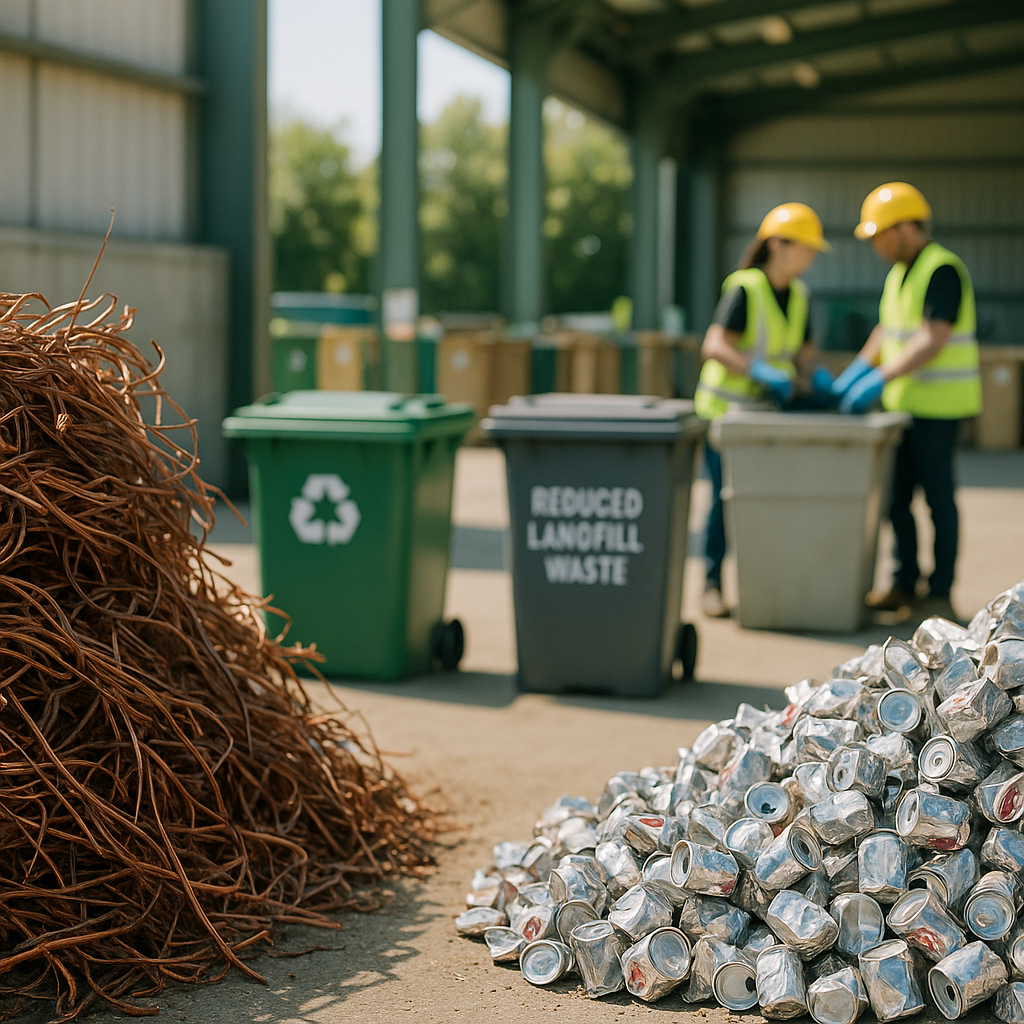5901 Botham Jean Blvd, Dallas, TX 75215
Scrap Electric Motors: Valuable Metals, Recycling Process, and Environmental Benefits
September 18, 2025Scrap electric motors are discarded or non-functional units that are no longer in service. These devices, which convert electrical energy into mechanical energy, are commonly found in appliances, industrial machinery, vehicles, and power tools. When motors become obsolete or fail to function properly, they are often replaced and considered scrap.
Electric motors power many machines in our daily lives. From the refrigerator keeping your food cold to the washing machine cleaning your clothes, these devices work silently until they eventually wear out. Industrial settings rely on motors for everything from conveyor systems to manufacturing equipment, while automotive applications include starters, window controls, and in electric vehicles, the main propulsion system.
When these motors reach the end of their useful life, they become valuable materials for recycling rather than waste. Each motor contains recoverable metals like copper, steel, and sometimes aluminum. This recovery process conserves natural resources and reduces the environmental impact of manufacturing new components from raw materials.
Where Can You Find Scrap Electric Motors?

Scrap electric motors can be found in numerous everyday items around homes, businesses, and industrial facilities. These components are one of the most commonly recyclable metal items, offering valuable materials for recycling when found in the right places.
Household Appliances
Many household appliances contain electric motors that become valuable scrap when the devices stop working. Kitchen appliances like blenders, stand mixers, and garbage disposals all include motors that can be recycled.
Major appliances are particularly rich sources of scrap electric motors. Refrigerators, washing machines, dryers, and dishwashers contain substantial motors. Even smaller items like desk fans, ceiling fans, and hair dryers have recyclable motors.
Don’t overlook less obvious sources. Microwaves, computer cooling fans, and space heaters also contain electric motors. Almost any household item that uses electricity and has spinning or moving parts contains a motor with recyclable components.
Industrial Equipment
Industrial settings offer abundant sources of larger scrap electric motors. Manufacturing equipment, industrial fans, blowers, and pumps typically contain significant motors with high quantities of valuable copper and aluminum.
Industrial pumps, including sump pumps, sewage pumps, and well pumps, all have motors. These durable units yield substantial recyclable metal at the end of their service life.
Garage door openers and other mechanical systems with chains, wheels, and gears operate with motors that can be salvaged. The motors in industrial equipment often weigh more than household varieties, increasing their value when recycled.
Automotive and Transportation Parts
Vehicles are excellent sources of scrap electric motors. Cars and trucks contain numerous motors beyond the starter and alternator. Power windows, windshield wipers, power seats, and electric fuel pumps all use small motors that can be recycled.
Electric and hybrid vehicles contain even more valuable motors. As electric vehicle adoption grows, the supply of recyclable motors from this source expands. These automotive components often contain high-quality materials.
The transportation industry generates substantial motor waste through regular maintenance and equipment upgrades. When buses, trains, and other vehicles are refurbished, their motors often become available for recycling.
Commercial Equipment
Businesses discard numerous electric motors from office equipment and commercial systems. HVAC systems, elevators, and commercial kitchen equipment all contain motors requiring eventual replacement.
Office equipment like printers, copiers, and scanners contain small motors. While these may be small individually, businesses upgrading technology often generate large quantities of recyclable materials.
Retail environments use motors in conveyor systems, automatic doors, and security systems. When stores remodel or close, these become available for recycling.
What Valuable Materials Are in Scrap Electric Motors?

Electric motors contain several valuable materials, making them ideal for recycling. The composition varies by motor type, but most include a mixture of metals and other recyclable components.
Copper Windings – The Most Valuable Component
Copper windings are the most valuable material in scrap electric motors. These coils conduct electricity and generally make up 7-18% of a motor’s total weight, depending on the motor type.
Small fractional motors often contain 9-10% copper by weight. DC motors are particularly valuable, with 15-18% copper content. This copper has excellent conductivity and recyclability, making it highly sought after in the recycling market.
The value of copper windings can vary significantly. At typical scrapyards, copper might fetch $2.50-$3.50 per pound. A 50-pound industrial motor containing 10 pounds of copper could net $25-$35 for the copper alone.
Steel and Iron Components
Steel and iron comprise most of the weight in electric motors, forming parts like the outer casing and rotor. Steel typically makes up about 90% of a motor’s total weight.
While less valuable per pound than copper, the volume of steel makes it important to recycling. Scrap steel typically sells for $0.10-$0.20 per pound, and recycling it saves significant energy compared to new production.
Cast iron components, often in motor housings or bases, are also recyclable, processed as a particular grade of scrap metal.
Aluminum Components
Many modern motors use aluminum parts to reduce weight. Common aluminum components include end bells, fan covers, and sometimes the outer casing.
Aluminum is highly recyclable and maintains its properties indefinitely. While aluminum windings exist, they are usually less valuable than copper windings. Correctly identifying aluminum versus copper components ensures appropriate compensation during recycling.
Rare Earth Magnets
Newer electric motors, especially in electric vehicles and high-efficiency applications, often contain rare earth magnets. These magnets, made from elements like neodymium, dysprosium, and samarium, are extremely valuable.
The recycling process for rare earth magnets differs from standard motor recycling. Specialized recyclers extract these magnets for reuse or material recovery. The growing demand for rare earth elements in green technology makes these components increasingly valuable.
Other Recyclable Materials
Besides the primary metals, electric motors contain other recyclable materials. Brass bearings and bushings hold recycling value. Insulated copper wire, while requiring additional processing, remains valuable.
Some motors also contain small amounts of silver in contacts or specialized components. Though present in small quantities, silver’s high value makes recovery worthwhile in larger operations.
How Are Scrap Electric Motors Recycled?

Recycling scrap electric motors involves systematically dismantling them to recover valuable materials. The most sought-after component is the copper windings, which can constitute between 7-18% of the motor’s total weight, depending on the type. Small motors typically contain a higher percentage of copper (9-10%) compared to their overall weight, while DC motors may contain up to 15-18% copper content.
The recycling process begins with an initial assessment of the motor. Recyclers remove external components like capacitors, plastic end-caps, and mounting hardware. These non-metallic parts are processed separately from the valuable metals.
The core dismantling process involves several key steps:
Separation of Components
Recyclers use specialized tools to disassemble the motor housing, removing screws and bolts to separate the outer casing from the internal components. The outer housing, typically made of aluminum or steel, also has recycling value.
Skilled recyclers can identify different metal types by sight or simple tests. For example, a file test can determine if a component is copper rather than another metal with a similar appearance.
Copper Recovery
The copper windings represent the most valuable material in scrap motors. These windings are carefully extracted from the motor core, sometimes requiring mechanical separation using saws, hammers, or specialized equipment. Professional recycling centers have industrial shredders to process motors efficiently.
Once separated, the copper windings are classified based on quality. Clean copper wire fetches the highest prices, while copper with enamel coating (common in motor windings) is classified as #2 copper and eventually melted down and refined for new applications.
Processing Steel and Iron
The steel or cast iron components, including the motor frame, shaft, and rotor, are sorted and processed separately. These materials make up the majority of the motor’s weight—approximately 90% in many cases. The steel is crushed, shredded, and eventually melted down for reuse in manufacturing.
In some instances, specialized industrial recyclers use electrochemical processes to recover copper from components where mechanical separation is challenging. This involves dissolving the copper in a chemical solution and recovering it through electrodeposition.
Environmental Benefits
Professional recycling of electric motors delivers significant environmental benefits. Recovering copper through recycling uses up to 85% less energy than mining and processing new copper. The process also prevents hazardous materials from entering landfills and reduces the need for raw material extraction.
While DIY dismantling is possible for small motors, professional recycling centers offer the equipment and expertise to handle large volumes efficiently. They can also ensure proper handling of any potentially hazardous components found in specialized motors.
What Are the Benefits of Recycling Scrap Electric Motors?

Recycling scrap electric motors offers significant benefits for both the environment and the economy. When these motors reach the end of their useful life, proper recycling recovers valuable materials like copper, aluminum, and steel. This reduces the need for energy-intensive mining and processing of new resources. Recycled copper from motors can save up to 85% of the energy required for new copper production, while steel recycling reduces CO2 emissions by approximately 58%.
In addition to conserving resources, recycling electric motors significantly reduces waste sent to landfills. Proper handling of these components prevents potentially harmful substances from contaminating soil and water supplies. Through specialized processing, materials that would otherwise occupy landfill space find new life in manufacturing supply chains, fostering a more circular economy where resources maintain their value longer.
Ready to responsibly recycle your scrap electric motors? Contact Okon Recycling at 214-717-4083 for professional metal recycling services that maximize material recovery while ensuring environmental compliance.
